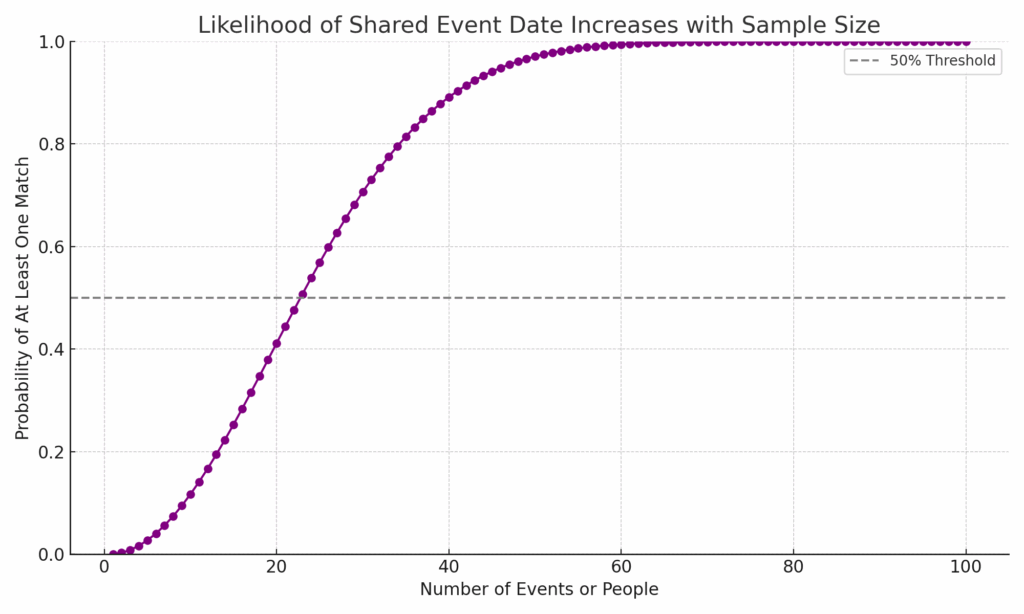A mallard duck being caught by a speed camera in Köniz, Switzerland, on April 13, 2018, and again on April 13, 2025, flying at 52 km/h in a 30 km/h zone, is indeed remarkable. This “repeat offender” incident has garnered attention due to its unusual nature and the precise seven-year interval between the two events.

Other time loops cases
This curious case is not isolated, some similar cases were recorded:
| Event Name | Time loop | Short Description |
| Twin Cyclists Killed | Initial Event Date: March 6, 2002 Recurrence Date: March 6, 2002 Time Interval: 2 hours | Twin brothers died the same day in identical bike accidents on the same road. |
| Duck Caught by Radar in Switzerland | Initial Event Date: April 13, 2018 Recurrence Date: April 13, 2025 Interval: 7 years | A duck was caught speeding by radar exactly 7 years apart, same date, same location. |
| Mexico Earthquakes | Initial Event Date: Sept 19, 1985 Recurrence Date: Sept 19, 2017 & 2022 Interval: 32 & 5 years | Three major earthquakes hit Mexico on the same calendar day, decades apart. |
| Franz Ferdinand Plate Coincidence | Initial Event Date: June 28, 1914 Recurrence Date: Nov 11, 1918 Interval: 4 years, 4 months | His assassination led to WWI; his car’s plate “AIII118” resembles the Armistice date 11.11.18. |
| US Presidents Dying on July 4 | Initial Event Date: July 4, 1826 (Adams/Jefferson) Recurrence Date: July 4, 1831 (Monroe) Interval: 5 years / symbolic | Three U.S. presidents died on Independence Day; two on the 50th anniversary of the Declaration. |
| Brothers Hit by Same Taxi (Bermuda) | Initial Event Date: 1974 Recurrence Date: 1975 Interval: 1 year | Two brothers were hit and killed by the same taxi, with the same driver and passenger, exactly one year apart. |
| Baby Falls Twice onto Same Man | Initial Event Date: 1937 (year) Recurrence Date: 1938 (year) Interval: 1 year | A baby fell from a four-story window onto Joseph Figlock in Detroit twice, both survived. |
| President Lincoln/Kennedy Parallels | Initial Event Date: 1865 (Lincoln’s death) Recurrence Date: 1963 (Kennedy’s death) Interval: 98 years | Numerous eerie similarities between Lincoln and Kennedy assassinations, lives, and successors. |
| Airship Disasters 25 Year Apart | Initial Event Date: 1912 (Zeppelin) Recurrence Date: 1937 (Hindenburg) Interval: 25 years | Both airships built by the Zeppelin family met fiery ends decades apart. |
| Mark Twain & Halley’s Comet | Initial Event Date: 30/11/35 Recurrence Date: 21/04/10 Interval: 75 years | Mark Twain was born in 1835, the same year Halley’s Comet passed Earth. He predicted he would die when the comet returned—and he did, in 1910. |
| Hoover Dam Fatalities | Initial Event Date: 20/12/21 Recurrence Date: 20/12/34 Interval: 13 years | The first fatality during construction was J.G. Tierney, a surveyor.The last fatality during construction was his son, 13 years later, on the same date (December 20). |
| Poe’s Richard Parker Prediction | Initial Event Date: 1838 Recurrence Date: 1884 Interval: 46 years | In his 1838 novel The Narrative of Arthur Gordon Pym, Poe described shipwreck survivors drawing lots to eat one crew member named Richard Parker. In 1884, a real shipwreck (the Mignonette) involved survivors killing and eating a man named Richard Parker. |
| King Umberto I and His Double | Initial Event Date: 1900 Recurrence Date: 1900 Interval: Same day | King Umberto of Italy met a restaurant owner who shared his name, birthday, birthplace, and appearance. The restaurant owner died in a shooting on the same day the king was assassinated. |
| Titanic and Futility Novel | Initial Event Date: 1898 Recurrence Date: 15/04/12 Interval: 14 years | In the book Futility, or the Wreck of the Titan (1898) by Morgan Robertson. An unsinkable ocean liner named Titan hits an iceberg in April in the North Atlantic. RMS Titanic sank in April 1912 under near-identical conditions. |
What should we do with this information? Does it make sense? If so, what is it? Or is it simply the result of probabilities?
Here are some possible interpretations:
Probability and the Law of Truly Large Numbers
Key Idea: In a world with billions of events and people, even extremely improbable events are inevitable.
- Proposed by Persi Diaconis & Frederick Mosteller.
- Law of Truly Large Numbers: “With a large enough sample, any outrageous thing is likely to happen.”
- Examples:
- People dying on the same date years apart.
- A duck being caught by radar again on the same date after 7 years.
Birthday Paradox Analogy
Key Idea: The probability of shared dates grows faster than intuition expects.
- In a group of just 23 people, there’s over a 50% chance that two share the same birthday.
- Applied to death dates or life events, the paradox shows how overlaps on dates are more likely than they seem.
Synchronicity (Carl Jung)
Key Idea: Some coincidences are meaningful, not causal — they resonate with internal or archetypal meaning.
- Synchronicity is a psychological framework, not a statistical one.
- Often used to explain dreams, déjà-vu, or emotionally charged coincidences.
- Criticism: Not falsifiable, but still widely referenced in anomalous or paranormal studies.
Chaos Theory and Initial Conditions
Key Idea: Tiny initial conditions can create large-scale patterns or echoes.
- Coincidences might arise from unseen patterns or recursive effects.
- Used in fields like meteorology, but the Butterfly Effect metaphor is often cited in coincidence discussions.
- Not predictive for specific coincidences, but frames them as emergent outcomes of complex systems.
Cognitive Bias & Apophenia
Key Idea: Humans are wired to see patterns — even when none exist.
- Apophenia: Perceiving meaningful connections between unrelated things.
- Confirmation Bias: We remember coincidences and forget all the non-coincidences.
- Cluster Illusion: We see clusters in random data (e.g., deaths on the same date) as more meaningful than they are.
Bayesian Inference
Key Idea: Updates our belief in the likelihood of an event as more information is added.
- You could model coincidences as Bayesian priors — adjusting belief in an outcome (like “deaths on same day”) based on new events.
- Rare repeated events increase the perceived likelihood of a pattern, even if it’s still statistically explainable.
Example Applied:
Regarding the case of the duck caught on radar exactly 7 years later
- At first glance: low probability.
- But if thousands of speed radars operate daily for years, the odds of at least one “quirky repeat” somewhere become significant.
- It’s expected from a large enough dataset — not mystical, but counterintuitive.
Here’s the chart showing how the likelihood of at least one shared date (like birthdays or event anniversaries) rises with the number of people or events:
- With just 23 people/events, there’s already a >50% chance of a shared date.
- By 50, the probability exceeds 97%.
- This is why repeated death dates or coincidences seem eerie — but they’re actually likely in large datasets.

Everyone will find meaning in these events, or not. It is certain that the exceptional nature of these recurrences encourages reflection and imagination. Ultimately, these are simply statistical probabilities applied to a given type of event. It is highly likely that if it were possible to systematically reference each type of everyday event, other similar occurrences would be observable.
Leave a Reply